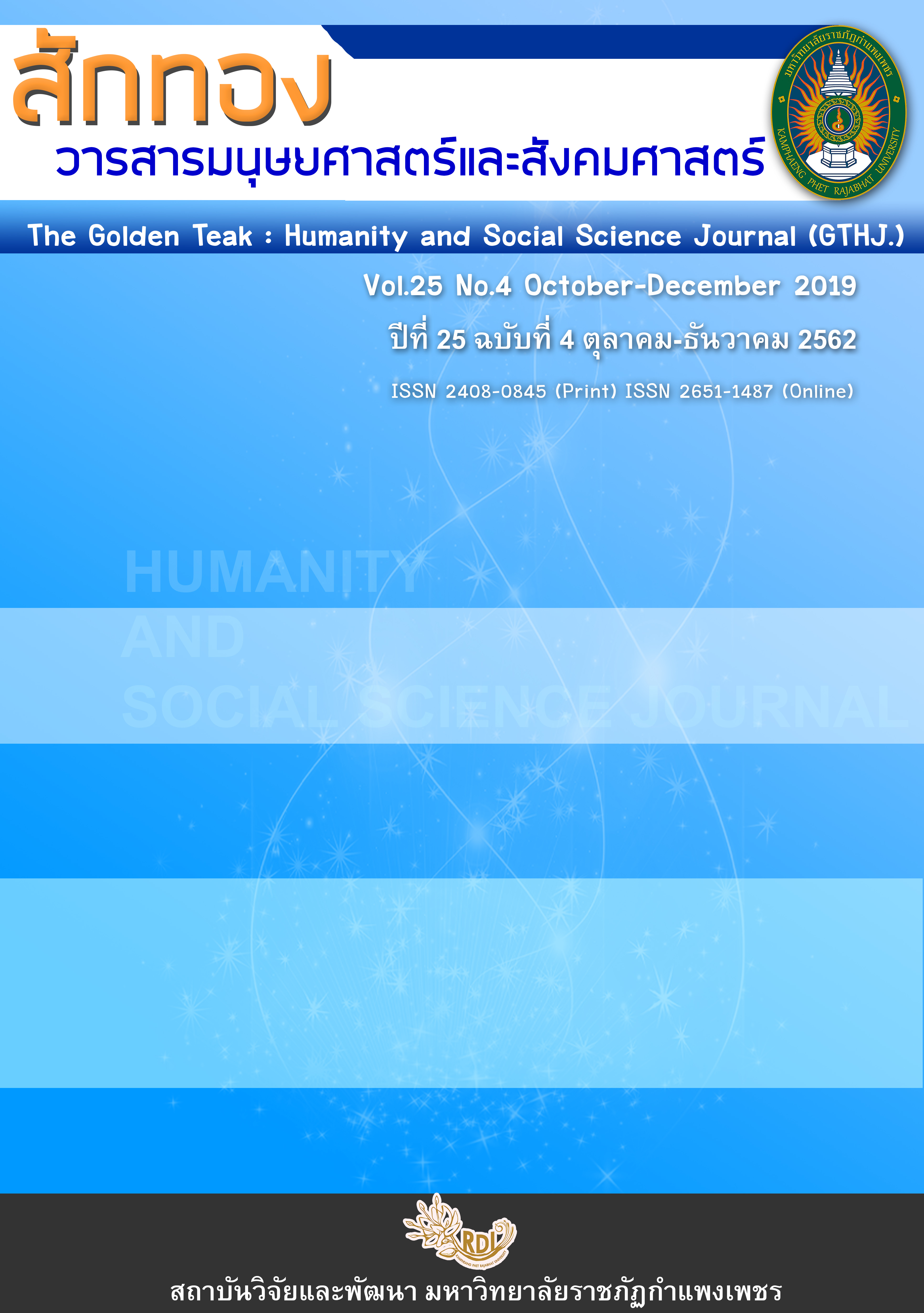The New Appearances under the Old Perception of Thai Literature in Thai Songs
Main Article Content
Abstract
This research is a study of the new appearance under the old knowledge of Thai literature in 14 modern Thai songs among 2013-2017 year, namely, Thotsakan Mana, Tuarai Thee Ruk Thur, Khun Chang (Loser man), Khon Nata MaiDee Thee Thur Yang Ruk, Ngor Par, Nai Jai Mee Nueng Deaw (Jak Jai Seeda), Phra Ram (Khor Thot Thee Hoo Bao), Matchanu (Khat Kwam Oboon), Ror (Nang Nguek), Seeda (I'm Sorry), Khan Mark Lom (Fail), Maichai Phra Ek (Foe), Wanthong, Hanuman and Huajai Thotsakan. The objective of this research is to study the presence of the Thai literature characters in the former times and to study the change of the main concepts of modern Thai songs from the past Thai literature by analyzing the 14 Thai song lyrics which are related to the characters of the past Thai literature. The findings show that the modern Thai songs create the lyrics by expressing ideas or inspirations from the characters in four main of Thai literature works Ramayana, Khun Chang Khun Phaen, Sung-Thong and Phra Abhaimani; moreover, there are two types of the characters appear in the songs. First is the appearance of the antagonist by using language to convince to sympathy mood. Second is the appearance with the protagonist by using language to express poor mood and difficult life. Besides, the change of the main concept of modern Thai songs classify in two kinds: Emphasis or Center of Interest and the used of contrasting artistic aesthetics which are different from Thai song in the past, because it aims to communicate the love of the two sides of characters by focusing on the tragedy ending or narrate the story of the bravery of the character to achieve confidence and faith. In addition, the new appearance of old Thai literature perfectly combines the concept and values through the old perception of modern Thai music.
Article Details
บทความที่ได้รับการตีพิมพ์เป็นลิขสิทธิ์ของวารสาร สักทอง : วารสารมนุษยศาสตร์และสังคมศาสตร์ สถาบันวิจัยและพัฒนา มหาวิทยาลับราชภัฏกำแพงเพชร
ข้อคิดเห็นใดๆ ที่ปรากฎในวารสารเป็นวรรณกรรมของผู้เขียนโดยเฉพาะ ซึ่งมหาวิทยาลัยราชภัฏกำแพงเพชรและบรรณาธิการไม่จำเป็นต้องเห็นด้วย
References
Master’s thesis, ChiangMai University,
Bigbite. (2016). Matchanu (Khat-KhwamOpOun). [Online]. Available : https://
www.facebook.com/notes/bp-furious/เนื้อเพลง-มัจฉานุ-ขาดความอบอุ่น/
1107608182652392 [2016, September 1].
Fine Arts Department. (2545). KhunChang KhunPhaen. (17th edition). Bangkok : Bannakhan.
Hemawong, S. (2016). Mai Chai Pra Eek (Foe). [Online]. Available :
https://www.siamzone.com/music/thailyric/12198 [2016, September 1].
Khanitsorn, N. (2016). Ror songs (Mermaid). [Online]. Available :
http://lyricry.blogspot.com/2016/07/blog-post_920.html [2017, September 1].
King Rama I. (2554). Ramayana. (2 nd ed.). Bangkok : Phetkarat.
Oudmuangkam R. (2008). A Study of the Sangthong as popular cultural literature.
Master’s thesis, Silpakorn Unversity, Nakhon Pathom.
Pratumwan, T. (2017). Hua jai Tossakan (Devil's Heart). [Online]. Available :
https://www.siamzone.com/music/thailyric/13025 [2016, September 1].
Satchaphan, R. (2011). Nomenclature Dictionary of Ramayana. Bangkok : Satapornbooks.
Senakham, T. (2006). Leaw Nah Lae Lang POP Cultural. Bangkok : Princess Maha Chakri
Sirindhorn Anthropology Centre (Public Organisation).
spokedark.tv. (2017). ชวนฟัง! 10 เพลงไทยยุคใหม่ที่ได้แรงบันดาลใจมาจากตัวละครในวรรณคดีไทย.
[Online]. Available : https://www.spokedark.tv/posts/song-inspire-by-literature/
[2016, September 1].
Thaiwannasri, P. (1986). Thai Literature from Soontharaporn songs. Master’s thesis,
Srinakarinvirot Pitsanuloke, Pitsanuloke.
Thinnaboot, P. (1990). Art & Emotional Expression. Journal of Khuruparithat, 15(1), 86-91.
Thippana, S. (2017, January-April). Creative Discourse in songs, August 7, Referendum
democratic stability by Office of the Election of Thailand (OECT). Journal of
Phraewakalasin Kalasin University, 4(1), 113-117.
Wongmanit, K. (2016). Tua rai thi rak ter songs (Tossakan). [Online]. Available :
https://www.siamzone.com/music/thailyric/11246 [2016, September 1].


